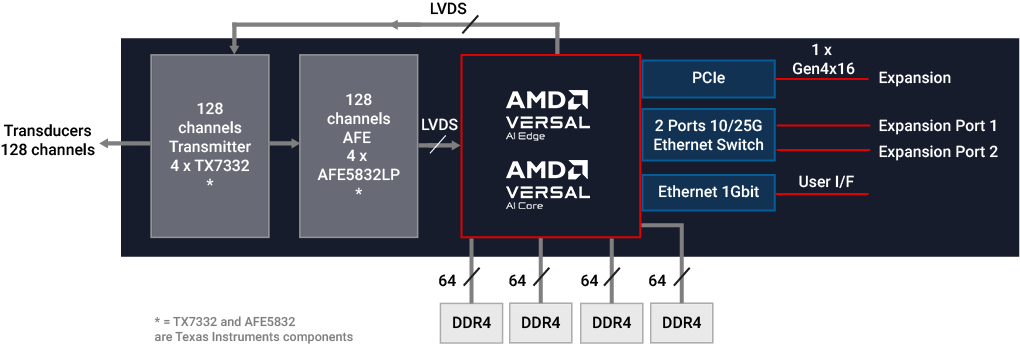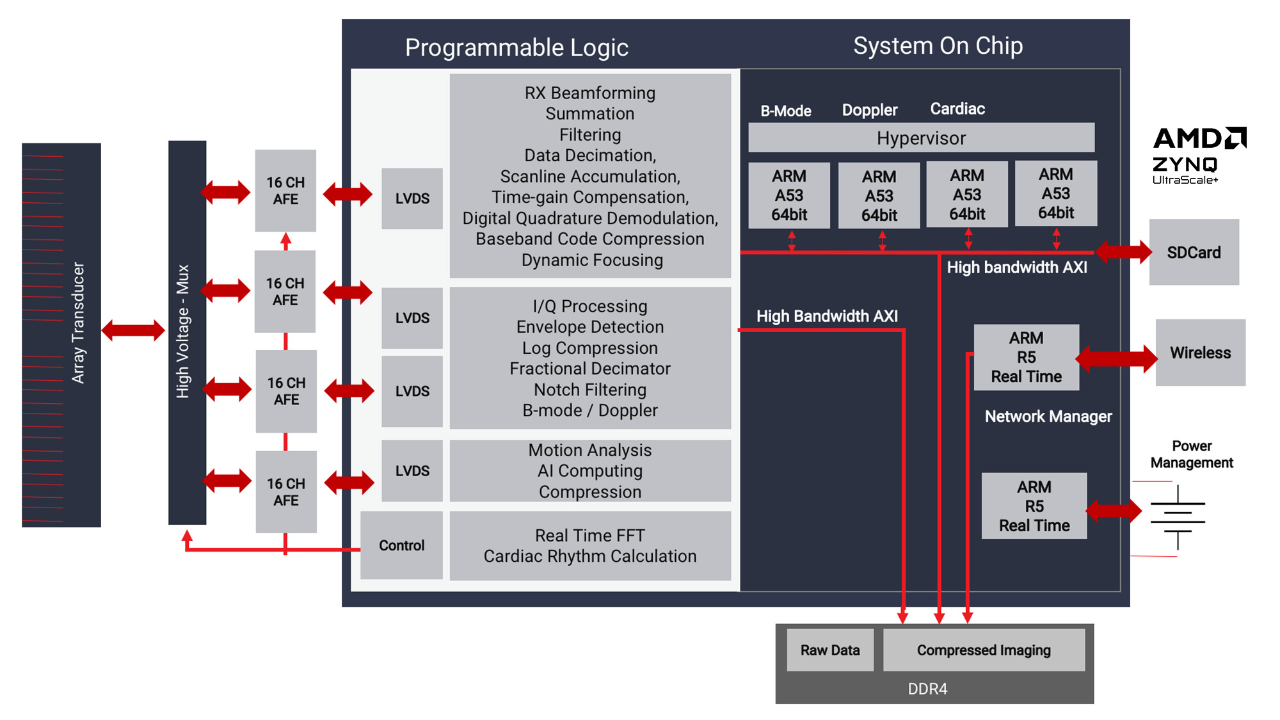- Applications
- Medical
- Medical Imaging with Ultrasound
Medical Imaging with Ultrasound
Create the next generation high image-quality ultrasound scanners for better diagnosis with superior thermal management for patient comfort.
In today’s ultrasound, channel count translates directly into higher resolution images and depth - both critical factors in detection and identification of issues. For these functions, the AMD UltraScale™ + family multiplies the DSP per logic cell ratio, for much higher signal processing capabilities per device. High speed serial transceivers provide a power efficient and fast interface to JESD204B compatible analog front-end components, significantly reducing the need for parallel IO, and thus also reducing power.
As channel count scaling becomes more difficult, AMD is enabling next generation Ultrasound design methodologies like Synthetic Aperture (used today in radars) and Planar Wave UltraFast advanced imaging techniques with its Versal AI Edge Series and the Versal AI Core Series adaptive SoC devices to help create much higher quality images at a lower cost and with better thermal management. The Versal AI Edge and AI Core series AI Engines have the ability to deliver very high frame-rates and strong AI performance with its tiled VLIW-SIMD parallel architecture.
With increasing requirements for more Point-of-Care (POC) Ultrasound solutions as Ultrasound moves more from clinics and hospitals to the field, maintaining performance, while being portable and connected, is an increasingly difficult challenge. Not only is it important to deliver performance for beamforming, but also real time image processing and analytics, all in the lowest possible power to increase battery life. The new Ultrascale+ ‘Cost-Optimized Portfolio’ from AMD and its newest additions, the Artix Ultrascale+ products and Zynq Ultrascale+ ZU1 provides industry leading compute density in the smallest form-factor and the best performance per watt for POC and portable Ultrasound platforms.
Design Example
Next generation Ultrafast imaging in ultrasound is a paradigm shift, where we can go from the normal sequential acquisition to a parallel acquisition of the whole plane, using either spherical or plane waves. This gives our customers the ability to do optimally focused images everywhere in the captured image, deliver extremely high-quality 3D/4D images and the ability to obtain thousands of images per second.
AMD adaptive SoC platforms like the AI Edge and the AI Core devices with its AI Engine based architecture are capable of delivering a beamformer running synthetic aperture or planar wave algorithms with 128 active elements and 200 lines of resolution on a single chip, and still obtain scan rates of several 100 to 1000 frames per second on anything from cardiac imaging to abdominal imaging to small-parts.
AMD ZYNQ-Ultrascale+ System-on-Chip (SoC) technology including the newly introduced ZU1 and new small footprint package offering called ‘inFO’, enables ultra-miniaturization of complex architectures such as parallel beamforming. This SoC technology, combined with our customer’s proprietary shared beamforming architecture, allows for the integration of up to eight parallel beamformers in a handheld device. This architecture places this system on par with high-end laptop and cart-based units based on pure processing power.

High-Performance and Adaptive Computing in Healthcare
New advances in technology are helping revolutionize the healthcare landscape. Download our eBook to uncover key industry challenges and learn how technology creates new ways to treat and diagnose diseases, power research, and enable doctors to perform surgeries with greater precision.





